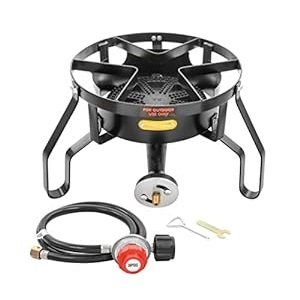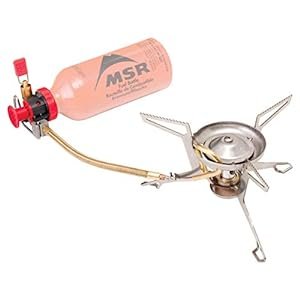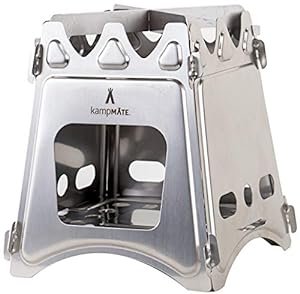How to Choose a Backpacking Stove
As you prepare for your camping, hiking, or traveling adventure, selecting the right backpacking stove becomes a crucial decision, especially for extended treks lasting several days. In today’s market, a plethora of lightweight stove options with diverse types and constructions are available. To aid in your decision-making process, this comprehensive guide offers valuable insights on how to choose the ideal backpacking stove to suit your needs.
How to Choose a Backpacking Stove
This step-by-step guide will help you navigate the process of choosing a backpacking stove, ensuring you make an informed decision based on key considerations.
The Different Types of Stoves
There are several types of stoves on the market:
- Gas stoves
- Multi-fuel stoves
- Wood stoves
Gas Stove: The Hiker’s Stove

Concord Banjo 16″ Portable Gas Stove
These are the stoves most used in hiking. They use a fuel mixture of propane and butane for combustion. The gas is stored in disposable cartridges. With a quite massive capacity (we remember the non-removable Concord Banjo stove), it is now light and compact. However, gas stoves use screw-on cartridges. During transport, you can separate the cartridge from the burner without any safety problems. This is extremely practical when transporting in a bag.
There are four types of gas stoves, each offering distinct features to cater to various preferences and needs. To facilitate your selection process, these stoves can be categorized as follows:
- Traditional Stoves: These models represent simplicity at its best. Lightweight, compact, and efficient, traditional stoves provide reliable burners for your backpacking needs.
- Duo Stoves: Comprising a valve that accommodates both threaded and non-threaded valve cartridges, Duo stoves boast versatility. This design ensures compatibility with a wide range of valve cartridges available in the market.
- Remote Cartridge Stoves (Reverse Cartridge): With this type, the burner is connected to the cartridge through a supply pipe. This configuration enhances stability and safety during meal preparation. This allows for the use of larger capacity pans. Inverted cartridge models enable stove functionality in low temperatures by promoting better gas mixing when the gas canister is turned upside down.
- Optimized Stoves: Representing an integrated 2-in-1 solution, optimized stoves consist of a burner paired with a specialized cooking pot. The cooking pot is equipped with a heat distributor, optimizing heating speed and fuel consumption. Additionally, this category includes stoves delivered with a saucepan for added convenience.
Advantages:
- Ease of use: just clip the cartridge to the burner, flick a lighter on the gas inlet, and off you go!
- High-performance burners on the market.
- Very fine adjustment of the intensity of the flame.
- Reliable and safe.
Power adjustable.
Disadvantages:
- Take up a significant amount of space in the backpack.
- Not easy to find cartridges on the spot.
- Very uncertain yield at very low temperatures (below -5°C).
- Not very eco-friendly.
Multi-Fuel Stove: Gasoline, Kerosene, Alcohol, Kerosene

MSR WhisperLite Multi-fuel Backpacking Stove
The advantage of a liquid fuel stove: gasoline, oil, or diesel can be found easily and everywhere in the world. The principle of this type of stove is simple: by operating a pump, the liquid fuel is pressurized, then passes over the burner, under the effect of heat, which transforms the liquid into a gaseous state.
There are two types of liquid fuel stoves:
- Multi-fuel Stoves (Gasoline): These stoves are designed to operate with white gasoline (C gasoline) or unleaded gasoline (95.98), as well as kerosene and diesel/diesel. The versatility makes them adaptable to different fuel sources and provides users with flexibility in choosing the most suitable option for their camping or hiking needs.
- Multi-fuel Stoves (Liquid Fuel and Gas Cartridges): Another type of multi-fuel stove is capable of working not only with liquid fuels such as petrol C and unleaded gasoline but also with gas cartridges featuring a threaded valve. This dual functionality allows users to switch between liquid fuels and gas cartridges.
The gas or multi-fuel stove can be used at any temperature. It performs very well even in cold weather. It is the stove for expeditions in the polar regions and the high mountains. This type is ideal for long-distance travel. However, the use of a gasoline stove is more complex than that of other systems. It requires attention: before it can be used at full power, it must be preheated. It requires regular cleaning and minor maintenance.
The supply of liquid fuel is easy and inexpensive. It is much more economical than gas. However, the stove is more expensive to buy. The fuel must be stored separately from the stove (in a bottle dedicated to the transport of flammable liquids). Unlike gas, liquid fuel is not under pressure when stored.
C gasoline is the cleanest liquid fuel on the market: it contains no residue. It is the ideal fuel for extreme cold weather and high altitude expeditions. If possible, choose this fuel!
Advantages:
- Does not fear the cold or the altitude.
- Fuel is easily found and economical (everywhere in the world).
- Power adjustable.
- Fuel is found absolutely everywhere.
- It has a very good performance even at low temperatures.
- You can only carry the exact amount of fuel.
Disadvantages:
- Gasoline smell.
- Bottle and gasoline weight.
- The complexity of use.
- Frequent maintenance to be carried out.
Wood Stoves: Eco-Friendly, Economical and Light

kampMATE WoodFlame Ultra Lightweight Wood Stove
Wood is a free and abundant natural resource! It is not necessary to transport it since the supply is done directly in the place of the fire. The user is completely autonomous and does not load unnecessarily.
The wood stove requires collecting kindling and maintaining the fire. Lighting takes practice, especially when the wood is wet. It is unusable in regions devoid of wood: glacial areas, deserts, and high mountains. With a wood stove, it is best to use an easily cleanable pot, because cooking with wood is messy: soot settles on the pan.
Some models of stoves are equipped with a double wall to optimize heat transfer and therefore increase performance. Several models of wood stoves are compatible with other fuels. If the wood runs out, you can replace it with solid or liquid alcohol. The use of a wood stove requires attention. It should not be used in areas sensitive to the risk of fire.
Advantages:
- You don’t have to carry fuel, just bend down to find wood.
- High efficiency with little wood.
- Ecological, no empty canister.
- Complete autonomy.
- A small outbreak is much friendlier than gas.
- No maintenance.
Disadvantages:
- It is limited to wooded areas.
- It blackens the meal.
- Smoke and smell of wood fire.
- Soot on the cooking pot.
Additional Features to Consider
Besides these, there are different criteria that allow you to know its performance.
- Weight of the Stove: Weight is one of the first criteria for choosing a backpacking stove. Be careful in your weight assessment to take into account that some stoves have accessories that add weight to the stove but remove it from the bag. For example, a stove with an integrated piezo means that you don’t need to take a lighter since the stove ignites on its own.
- Wind Sensitivity: The wind sensitivity is the same for all single stoves but may vary for optimized stoves. To improve the wind resistance of your stove you can use a finned pan or a windscreen.
- Stability: The stability of the stove is the result of two factors: The foot of the gas bottle and the width of the stove head supports. It is often at the foot of the bottle that the cooking pot can tip over, especially if the bottle is on unstable ground. The stability is therefore roughly equivalent for all stoves that screw onto the bottle. To improve this, you can buy a stabilizer that is fixed under the bottle.
- Clutter: This is also one of the important criteria and there are great differences in size between the stoves. It is the architecture of the stove that makes the difference and there are dozens of them. Remember that remote cartridge stoves are much less compact than the others.
Conclusion
The choice of a backpacking stove hinges on the nature of your activities. For those engaged in highly mobile pursuits such as hiking and trekking, prioritizing something extremely small, lightweight, and reliable is essential—a stove that seamlessly fits into your backpack without adding significant weight. But if you don’t have space problems and you have decided to use the stove only when camping and not while traveling or on long treks, then the other models are just as good.
Have fun on your next trip. If you have any questions leave them in the comments.
Frequently Asked Questions
What are the advantages of traditional stoves over other types?
Traditional stoves are simple, lightweight, compact, and efficient. They are a great choice for those who prioritize ease of use and minimalism in their backpacking equipment.
Can optimized stoves with integrated cooking pots enhance cooking efficiency?
Yes, optimized stoves with integrated cooking pots often come with features like heat distributors, optimizing heating speed and fuel consumption. This can enhance the overall cooking experience.
Read Also…






